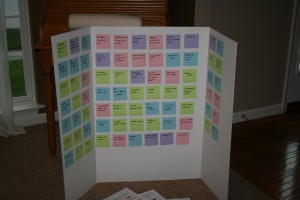I have no problem writing them. In fact, I have written several novel queries and synopses for clients and for myself. But sending them out is another matter.
I have written four fiction novels to completion and I have never sent a query letter out for even one of them. This makes me a rarity among many fiction writers. It seems everyone finishes their first draft and then mails off a series of query letters. It frustrates me that so many authors clutter up the agent’s in-box with unpolished manuscripts. But if I am honest, I am mostly jealous of their confidence.
Querying is asking the popular boy to go steady–something I only did once in middle school to fantastic failure. It is inviting someone to tell you No. And it is believing your work is polished to the best of your ability.
I’ll share this draft with a small selection of readers who can point out its story issues and gaps. Then I will go fix those problems, while revisiting the language. And then I will start all over again, revising, editing and tweaking. So far, on my many drawer novels, I have yet to reach a point where I feel it is work worth sending out.
When my kids were babies, I read a book a day. As the supreme-book-picker-outer for two book clubs, I have to read at least 20-30 books a year to make my book club selections. And as a writer, I find it hard to read and write at the same time.
Conservatively, I would say that I read between 60-90 books a year. I tend to binge on them–eight in a week followed by two weeks of writing. Last summer, I took 17 books on my eReader and read them all on a six day cruise and three days of travel.
I love that I have friends from all over the country who still email me with book suggestions. Many times I have already read them but it is nice to see what books they think I would like. (Most of them deal with some level of dysfunction…hmmmmmm…)
Here are some of my favorite books, in no particular order:
 Poisonwood Bible by Barbara Kingsolver
Poisonwood Bible by Barbara Kingsolver
If you have not read this book, you have missed one of the literary greats. As a fan of multiple point of view stories, this is a shining example. The language is pitch perfect, the story is riveting and the themes are complex.
My church-based book club read this book and it made for a fabulous discussion. A book about menstrual cycles in Biblical times is an arresting logline but the stories are unique. Based on Rachel and Leah from the Old Testament, its an interesting peek into catty women and their difficult relationships–fueled by PMS.
The oldest and least read on this list. I read Phantom in college, at the height of Andrew Lloyd Webber’s musical. It tells the story of Erik and Christine before and after the story we all know. I love it for its backstory and its exactly adherence to Gaston Leroux’s original novel, which was written as a police report. Brilliant!

Katrina is one of my favorite authors of all time–and a good friend. Her book, The Blessings of the Animals is her most recent book and one I can wholeheartedly recommend to all audiences. Kindness of Strangers is my favorite though. It follows a young boy who has suffered sexual abuse at the hands of his parents. The story is not about the abuse though. It is about his triumph over it–scars and all.
The Help by Kathryn Stockett
A lesson in capturing voice, I walked through two stores while my husband carefully guided me around poles and other shoppers, because I could NOT stop reading this book.
Joshilyn Jackson is an online friend who was kind enough to take me along for lunch at a conference we attended. We discussed Joss Whedon, Indian food and revisions. I fell in love with Gods in Alabama–in part because of its first paragraph. I was thrilled then when she wrote a sequel of sorts in Backseat Saints. Both are excellent and you can read them in any order.
I just saw Sara last week at an event, where she discussed the upcoming movie, her research methods and her love of animals. Sara is one of the heroes of NaNoWriMo,having written three of her first drafts in the month of November. Water for Elephants has delicious twists and turns. I was convinced she had wrote herself into a corner until I read the end. Brilliant!
 Still Alice by Lisa Genova
Still Alice by Lisa Genova
I have cried over exactly two books. This is one of them. Unfairly, Lisa is a bestselling author, a brain surgeon (!!) and gorgeous. I’d like just one of those traits. Still Alice is about early onset Alzheimers and Lisa wrote it from the patient’s point of view. Talk about an unreliable narrator. Alzheimer’s looms on my horizon and this book was both educational and terrifying. And in the end, it was heartbreaking.
Clever and sweet, this book was published after the author’s death (Mary Ann). I mourn that we won’t have more books from her. Each of these characters come to life and still live on in my brain.
There are so many more to suggest.
What are some of your favorite books?
katrina kittle
 Editing has turned out to be a tangled, complicated experiment. And my only defense is $5 worth of colored Post It Notes.
Editing has turned out to be a tangled, complicated experiment. And my only defense is $5 worth of colored Post It Notes.
When I started Dismantling Spider Webs (DSW) last year, I had a fully fleshed out outline with all my sub-plots, character motivation and satisfying conclusion. It was condensed to a clever Excel spreadsheet and everybody fit nicely into their cells.
Darren of Wordsworth and editor extraordinaire, ate noodles with me and gave me all sorts of fun ideas on what could happen. He helped shape the ending and made several astute modifications to my original trajectories.
Prior to starting DSW, when it was still incubating in my mind, I took a writing intensive with novelist, Katrina Kittle. Her insight on dialogue, plotting, tension and motivation helped to poke holes in my outline. And I heard her voice as I wrote, guiding me towards less exposition and more authentic dialogue.
Writing DSW was effervescent! The characters ran willy-nilly across the pages, surprising me with thing they said and pranks they pulled. Three characters fell off the page, never to return again. One character begged to have her own book. (I am seriously considering her request.) And even in its sloppy, messy conclusion, I had a good rough draft.
But it is entirely prohibited from human consumption. Like uncooked puffer fish, it might kill you if you read it in its unfinished state. But there was promise there–buried under rudimentary words and cliche. With proper editing and several red pens, I dreamed it might be redeemed.
Enter the editing phase
I wish I liked editing more. When I am actually doing it, it’s not so bad. But the process makes me feel stupid.
I know these characters intimately. But I can’t remember if I referred to Lorelei’s adoption on page 12 or page 32. Is her nickname explained by Chapter 9 so can I use it in Chapter 10? Did the reader know her hair was long before I had her cut it off in a pivotal scene?
When I started DSW, Lorelei hadn’t been adopted. She did things with a certain lack of motivation. But after letting my brutal (but kind) friend, Jeanne, smack around my plot and characters, I realized she needed a defining reason to act the way she did.
So now there are new motivations, better designed characters, a few condensed characters, a reordering of plot points and more scenes to write. The only way I can keep it straight in my head is by diagramming it in Post It notes.
I am still holding onto the thread of hope that DSW is redeemable. And I sincerely hope this isn’t all just a “good learning experience.”
And I hope CVS doesn’t run out of Post It Notes.








